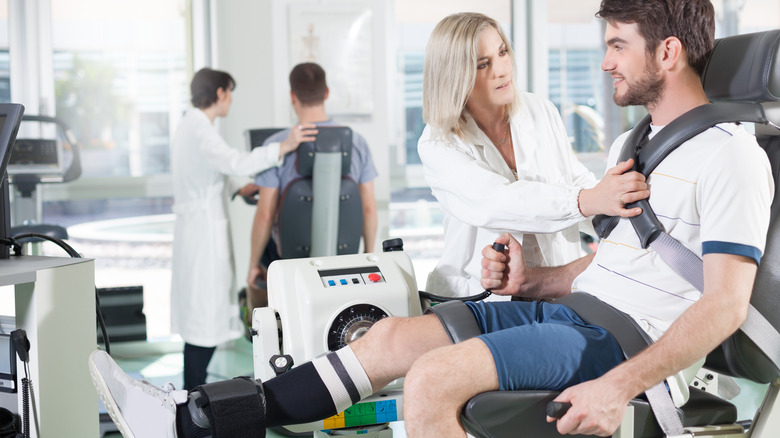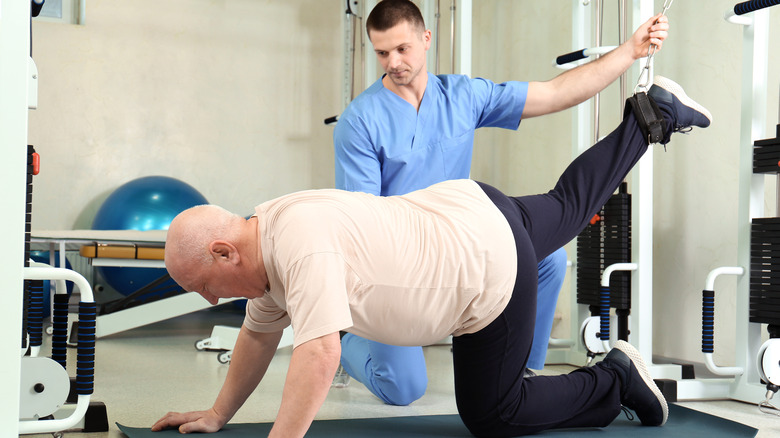What You Should Know About Isokinetic Exercises
If you're a seasoned weight lifter, most of your training plan probably includes isotonic exercise, says Healthline. However, if you've ever seen a physical therapist or had rehab for an injury, you probably won't be doing heavy squats. Instead, you've probably done some isokinetic exercises on a machine. Isokinetic machines allow you to test the strength of your muscles and give you a readout of your progress. They can also show the areas of weakness along a specific range of motion that need improvement, according to Sports M.D.
Isokinetic exercises use a dynamometer to control the speed of a specific movement, such as a stationary cycle. Rather than use your strength or endurance to burst through each revolution, the dynamometer fixes the revolutions. For example, a physical therapist might have you perform 80 revolutions per minute on a stationary cycle. If you try to go faster, the dynamometer will add more resistance so that you stay at the set speed. If you go slower, the machine will ease up, explains azcentral.
You probably won't see an isokinetic machine in a typical gym because you'll need someone who understands the complex equipment to operate it. That's why isokinetic machines are usually found in physical therapy and sports rehabilitation facilities (via Healthline).
What's the difference between isokinetic, isometric, and isotonic exercise?
According to Fusion Rehabilitative Medicine, isotonic exercises involve strengthening the muscle by moving a fixed weight through a range of motion. For example, you could pick up a dumbbell for a bicep curl, and how fast you curl the dumbbell is up to you. The resistance doesn't change as you move at your own pace.
With isometric exercise, both the joint and the muscles around it stay fixed. You could hold a dumbbell at shoulder height to get an isometric contraction. Although the weight might be different, it doesn't move. Think of an isometric exercise as trying to push a large boulder. The weight doesn't move, but your muscles will gain strength.
Mountain Physical Therapy states that isokinetic exercises mean the speed of the movement is fixed, and the resistance will vary. Because the resistance changes through the range of motion, you can locate weak areas along your range of motion and strengthen them. Isokinetic exercises also have the least risk of injury.
What the research says about isokinetic exercise
Some research studies compare isotonic, isometric, and isokinetic exercise among people recovering from injuries or physical conditions. A 2022 study in Cureus divided 60 patients with osteoarthritis into isotonic, isometric, and isokinetic programs. All participants exercised five days a week for three weeks and reported that they had less pain at the end of the study. Although the isotonic group increased their peak torque in the left knee, the isometric group improved their strength and cartilage after three weeks.
Isokinetic exercise can also be used to determine whether athletes are strong enough to compete after surgery. A 2018 study in the Journal of Athletic Training used an isokinetic device to measure the strength of athletes after knee surgery. The study determined the optimal strength for the rehabilitated knee so that it was safe for the athlete's return to play.
Another study found that isokinetic exercise did better than isotonic exercise to improve the range of motion in the shoulder. A 2020 study in the Orthopaedic Journal of Sports Medicine studied healthy participants to find that isokinetic exercise could better strengthen the infraspinatus muscle, which is one of the key muscles in the rotator cuff. The study suggested that isokinetic exercise might be better to heal rotator cuff injuries.



